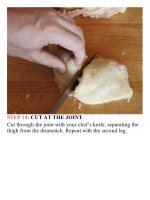The food lab better home cooking through science ( PDFDrive ) 110
Bạn đang xem bản rút gọn của tài liệu. Xem và tải ngay bản đầy đủ của tài liệu tại đây (176.62 KB, 2 trang )
Aneggyolkfollowsadifferentsetoftemperatures:
•At145°F:Theyolkproteinsbegintodenature,thickening
theliquidyolk.
•At158°F:Theeggyolkisfirm,abletoholditsshapeand
to be cut with a fork or knife. Its appearance is still dark
andtranslucent,withanalmostfudge-liketexture.
• Between 158° and 170°F:The yolk becomes firmer and
firmer until eventually it suddenly shifts from translucent
and fudge-like to pale yellow and crumbly as tiny
spherical chambers invisible to the naked eye separate
fromeachother.
•Above170°F:Theyolkbecomesincreasinglycrumblyas
the temperature goes up.The sulfur in the white rapidly
reacts with the iron in the yolk, creating ferrous sulfide,
tingeingtheoutsideoftheyolkanunattractivegreen.
Boiling eggs is all about balancing the differences
betweenthewaythewhitesandtheyolkscook.
SOFT-BOILEDEGGS
For me, the ideal soft-boiled egg has a white that’s
completely opaque, but not to the point of rubberiness
(somewhere in the range of 155° to 180°F), and a yolk
that’sprettymuch100-percentliquid(nohotterthan158°F).
Inthisway,witheachspoonful,yougettenderbitesofsoft,
velvety-smooth white bathed in a sauce of glorious, bright
golden,rich,flavorfulyolk.
So,rememberingthatfoodscookfromtheoutsideinand
that the hotter your cooking environment, the greater the
temperaturegradientthatformsinyouregg,yourealizethat
for soft-boiled eggs, you want to start withcold eggs and
submergetheminhotwater,sothatthewhitescookandset
while the yolks remain liquidy. I tried plunging the eggs
directlyintoboilingwatertocookuntilthewhiteswerejust
set, but I ran into a problem: the outermost layers of the
whites end up slightly overcooking.A much better way to
do it is to bring a pot of water to a boil, shut off the heat,
drop the eggs into it, cover the pot to help it retain some
heat,andthenstartthetimer.Sincethewaterinthepotgets
cooler as it sits, the eggs stand much less of a chance of
overcookingandturningrubbery.
Theotherimportantthingtoconsideristheratioofwater
to eggs—add too many eggs, and they’ll cool the water
downsomuchthattheywon’tcookproperly.So,3quartsis
enoughwatertocookupto6eggs.Anymorethanthat,and
you’llwanttocookinbatches,orinalargerpot.









